Contents
- Current (through May 2) degree day (DD) Accumulations
- Current bud stages
- Upcoming meetings
- The way I see it
- 2011 New England Tree Fruit Management Guide Available
- Updated Trac pesticide recordkeeping software available
- MassCon Project -- http://masscon.blogspot.com/
- Guest Article -- USING THE APPLE IPM WEBSITE TO GET A HEADS-UP ON INSECT ACTIVITY
- Useful links
Current (through May 2) degree day (DD) Accumulations
Location: UMass Cold Spring Orchard (CSO), Belchertown, MA
Base 43: 263
Base 50: 105
Significant upcoming orchard insect events based on degree days (Base 43):
Pear psylla 1st egg hatch: 174-328
Redbanded leafroller 1st flight peak: 231-365
Spotted tentiform leafminer 1st oviposition: 143-273
Spotted tentiform leafminer 1st flight peak: 264-294
European red mite egg hatch: 231-337
Obliquebanded leafroller larvae active: 158-314
Oriental fruit moth 1st catch: 222-324
Lesser appleworm 1st catch: 263-567
Current bud stages
| Location | McIntosh apple -- |
Gold Bosc pear -- white bud |
Burgundy (Pearl) cherry -- bloom | PF14 Jersey peach -- early bloom |
| Belchertown UMass CSO (05/02/11) |
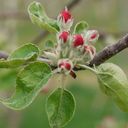 |
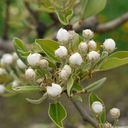 |
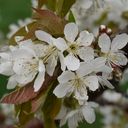 |
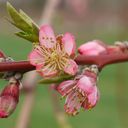 |
Upcoming meetings
May 17, 18, 19: Tree fruit twilight meetings, TBA
May 20: UMass Good Agricultural Practices Training, Berkshire Room, University of Massachusetts Collaborative Services Facility, 333 South Street, Shrewsbury, MA 01545-4169. Pre-registration required at dyork@umext.umass.edu.
June 14, 15, 16: Tree fruit twilight meeting, TBA
July 18, 2011: Massachusetts Fruit Growers' Association Summer Meeting, Parlee Farms, Tyngsoboro, MA
The way I see it
Really pretty quiet and the weather has been good. Sweet cherry in full bloom @ Belchertown, pears in bloom in the metro-Boston area. Apples will be in bloom by early next week.
We are headed into the period of maximum apple scab risk, and it has been intermittently wet for a couple weeks, and it is forecast to be so, so if you have not already applied an SI/DMI fungicide (Inspire Super, Rally, Vintage, Indar or Procure) along with your protectant fungicide it is recommended you do so during this pre-bloom, bloom, and post-bloom period. See your 2011 New England Tree Fruit Management Guide for all fungicide options during this period.
Fire blight risk for those of you with open pear and soon-to-be apple bloom appears to be minimal for the foreseeable future. (But keep an eye on the weather if the forecast changes.)
Open bloom in stone fruit -- peaches, cherries, plums -- should be protected with a fungicide during the forecast upcoming wet period to minimize brown rot infections down the road. See your 2011 New England Tree Fruit Management Guide for all fungicide options during this period.
The majority of this week's Healthy Fruit will be devoted to the reprint of an article from Scaffolds Fruit Journal on NEWA (Network for Environment and Weather Applications.) Massachusetts has become a partner in NEWA and I encourage you to use the website -- I think you will find it very useful in helping make integrated disease and insect management decisions as well as choosing pesticide control options.
JC
2011 New England Tree Fruit Management Guide still available
As a reminder, the 2011 New England Tree Fruit Management Guide is still available for purchase here:
http://www.umass.edu/fruitadvisor/2011/2011netfmg.html
The 2011 New England Tree Fruit Management Guide (NETFMG) is available NOW. For $50 you will receive the printed guide by postal mail. You can download and print a mail-in form to order the NETFPMG by personal check here.
Note that for 2011 the herbicide/weed control section has been completely revised, and all sections have been carefully reviewed for changes in 2011. Order yours today!
Also note that Commonwealth Quality produce certified growers should have the 2011 NETFMG in their possession to achieve the maximum score!
JC
Updated Trac pesticide recordkeeping software available
Updated for 2011 Trac pesticide recordkeeping software from the New York State IIPM Program for tree fruit (apple, cherry, peach-nectarine, and plum) is now available here for purchase:
http://www.cctec.cornell.edu/express%20licensing/software/tracsoftware/index.php
It's my opinion TracApple, TracPear, TracCherry, and TracStoneFruit are the best pesticide recordkeeping applictions available, and well worth the purchase price. A single Trac software is $60;
the TracTreeFruit Bundle that includes TracApple, TracPear, TracCherry and TracStoneFruit is $180.
JC
MassCon Project -- http://masscon.blogspot.com/
This blog documents efforts to evaluate containment spraying in apple orchards in Massachusetts. The project was funded by a USDA Specialty Crops Block Grant from the Massachusetts Department of Agricultural Resources.
MassCon Project Purpose: With the adoption in commercial apple orchards of fully dwarfed trees and ultra-high-density planting/training systems, containment or tunnel spraying becomes a feasible alternative to conventional airblast spraying. By spraying only within a canopy extending on both sides of the row being treated, tunnel spraying can dramatically reduce drift of agricultural chemicals to non-target areas and substantially decrease the quantity of chemical required. The potential environmental benefits are unmeasured. The quality of pest control should be enhanced, while at the same time, significantly reducing the quantity of pesticide used. A change in methodology such as this can only enhance the sustainability and competitiveness of apple farming in a steadily urbanizing part of the Country.
The Massachusetts Fruit Growers’ Association (MFGA), in partnership with the University of Massachusetts Fruit Program (UMass), will address the following objectives:
- demonstrate the feasibility of tunnel-sprayer technology in Massachusetts orchards, some with uneven terrain and small blocks;
- measure pesticide delivery to target trees and estimate drift to demonstrate that this approach will reduce environmental risk within and near orchards;
- assess efficacy of much-reduced pesticide application rates per acre in an effort to adjust rates and recommendations to account for much smaller tree volume per acre;
- compare the economics of higher technology application procedures and much reduced application rates to conventional approaches, assessing the economics of expensive but greatly reduced-risk alternatives; and
- institute educational programs in the forms of grower demonstrations, workshops, written and web-based factsheets, and videos.
WA
Guest Article -- USING THE APPLE IPM WEBSITE TO GET A HEADS-UP ON INSECT ACTIVITY
Art Agnello and Harvey Reissig. Reprinted from Scaffolds Fruit Journal, Vol. 20, No. 7, May 2, 2011.
Apple growers in the Eastern US have faced challenges in managing the complex of insects and diseases of apples using conventional pesticides during the last decade because of increasing pesticide regulatory restrictions, public concerns about food safety and environmental quality, and the development of resistance to older materials by key insect and disease pests. Growers are attempting to turn to newer, reduced-risk pesticides, but these are more expensive and require more precise use patterns because of their different modes of action. In addition, many current IPM protocols were designed for older conventional materials. During the last several years, an interdisciplinary group of researchers at Cornell University has developed a web-based, "Real-Time" Apple IPM Decision Support System that can deliver relevant, current information on weather data and pest populations to facilitate grower pest management decisions throughout the growing season. This system tracks seasonal development of key insect pests and diseases using Degree Day and Infection Risk models. The models indicate pest status, pest management advice and sampling options, and are linked to an interactive system that helps growers choose appropriate materials when pesticide use is recommended.
Insect pest developmental stages are calculated from Degree Day (DD) accumulations at IPM's NEWA and National Weather Service airport weather stations throughout the state, as well as a large number of sites in MA and VT, plus several in CT, RI, NJ, and PA. The insect pests addressed by this website are: apple maggot, oriental fruit moth, codling moth, plum curculio, obliquebanded leafroller, and spotted tentiform leafminer. Disease predictions are available for apple scab and fire blight, and a summer disease (sooty blotch and flyspeck) development model is due to be made available this summer.
Access to the Apple Insects models is through the "Pest Forecasts" list or the "Apples" link on the NEWA home page (http://newa.cornell.edu). From the Apples homepage, clicking on the link that says "Apple Insect Phenology Models and IPM Forecasts" brings up a state map showing the available weather stations, plus pull-down menus on one side (Fig. 1).
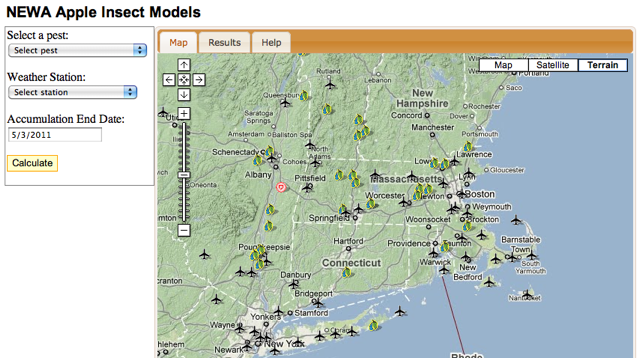
Fig. 1
After the user selects a weather station, pest of interest, and the desired end date for weather data accumulation, pest DD models and historical records are used to calculate: Tree Phenological Stage, Pest Stage(s), Pest Status, and Pest Management Information, all of which appears on a "Results" page (Fig. 2).
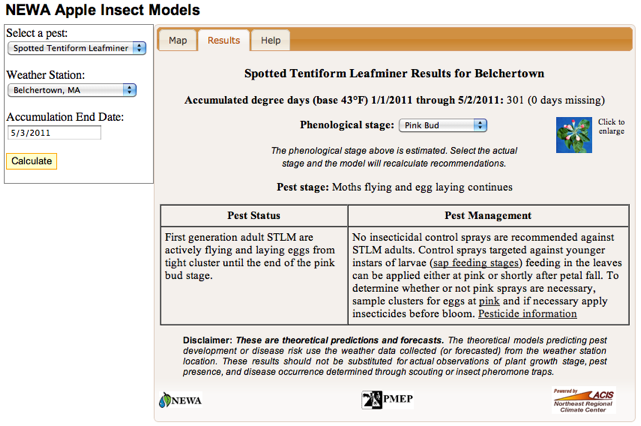
Fig. 2
The phenological stage can be adjusted according to field observations by selecting from a pull-down menu; this will generally change some of text provided in the advice boxes. Hyperlinks on this page can take the user to various other online resources, such as color photos of the bud development stages, NYS IPM Fact Sheets of the pests in question, and when appropriate, sampling charts for use in conducting field samples of specific pestlife stages (e.g., eggs, larvae, mines). When a pesticide spray is recommended, a "Pesticide Information" link in the "Pest Management" box takes the user to the Pest Management Education Program's (PMEP) Tree Fruit IPM home page, where a pesticide decision filter helps users pick an appropriate material to use, based on anticipated pest severity and program type (Fig. 3).

A pesticide search returns a series of profiles of all the NY-registered products fitting the speciifed pest species and efficacy rating (Fig. 4). The profile gives the common and trade names, labeled use rate, re-entry and pre-harvest intervals, and EPA registration number of each product. Also includes are some general remarks on the range of product efficacy, and any known effects on beneficial species. A "Details" link in each profile takes the user to a more extensive list of information, including
notes on the active ingredient (including its mode of action classification), an overview of the recommended pesticide use periods, and a link to a scanned copy of the NYS DEC-approved product label, which can be read or printed.
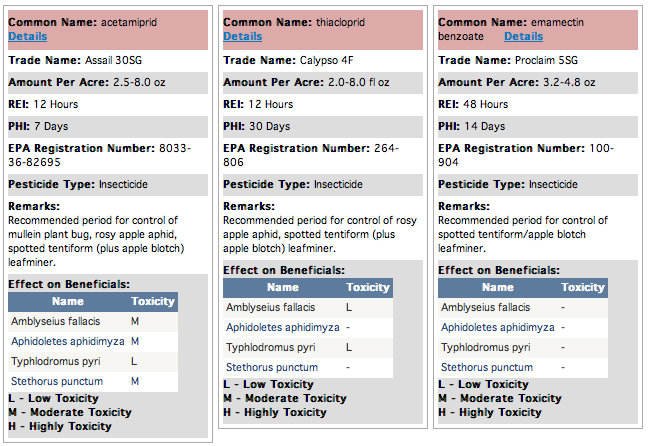
All of the information presented is already available online at various other university sites, but this website brings these resources together in one place that is more convenient and efficient to access. Predictions provided by the website can be refined and adjusted to reflect current insect activity by user-entered events obtained through field monitoring (such as pest biofix; i.e., the first suspected flight of a pest species). The pesticide selection filter uses Cornell University product efficacy ratings and the type of management program selected by the user (i.e., conventional, reduced-risk, non-organophosphate, organic).
The website uses DD information based on either historical records or user-entered biofix data, and includes: the start, peak, or progress of the oviposition or egg hatch period (for CM, OBLR, OFM, and STLM); the start, peak, or progress or end of the pest's 1st, 2nd, etc. flight (for AM, CM, OBLR, OFM, and STLM); the first occurrence of adult or larval feeding, foliar or fruit damage, or mines (for
OBLR and STLM).
We are continuing to refine and improve the accuracy of the website's pest predictions, and expand the range of sites from which weather data is able to be collected. During this process, we encourage everyone in the apple industry to check this website for themselves throughout the growing season, to see how well it forecasts pest events in specific areas of the state. We appreciate hearing of any anomalies or irregular predictions generated by using the local data to chart pest or disease development in your growing area, and hope to end up with a pest management tool that is useful and accurate for advising apple growers about what's going on in their orchards in Real-Time.
Useful links
UMass Fruit Advisor http://www.umass.edu/fruitadvisor/
Scaffolds Fruit Journal http://www.nysaes.cornell.edu/ent/scafolds/
Network for Environment and Weather Applications (NEWA)
JMCEXTMAN Blog http://jmcextman.blogspot.com/
Follow me on Twitter http://twitter.com/jmcextman and Facebook http://www.facebook.com/jmcextman
